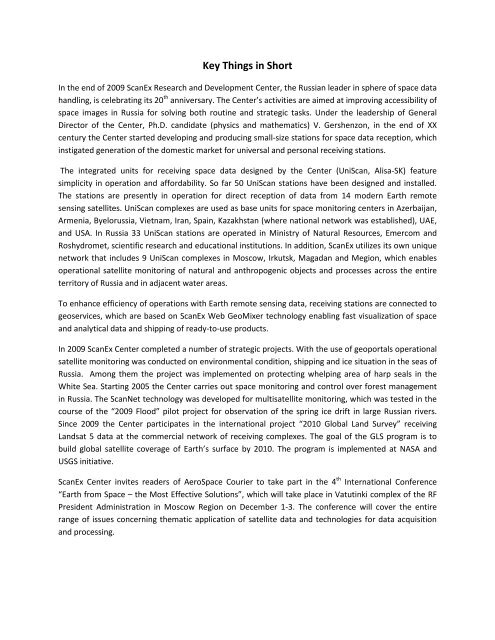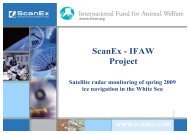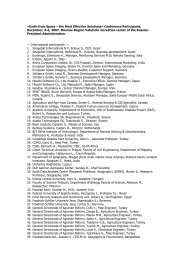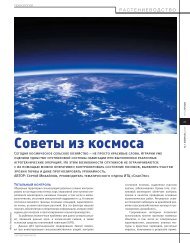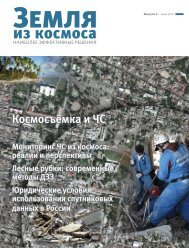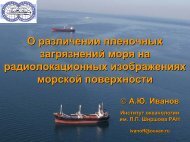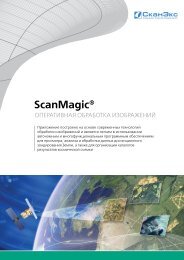Key Things in Short
Key Things in Short
Key Things in Short
Create successful ePaper yourself
Turn your PDF publications into a flip-book with our unique Google optimized e-Paper software.
<strong>Key</strong> <strong>Th<strong>in</strong>gs</strong> <strong>in</strong> <strong>Short</strong><br />
In the end of 2009 ScanEx Research and Development Center, the Russian leader <strong>in</strong> sphere of space data<br />
handl<strong>in</strong>g, is celebrat<strong>in</strong>g its 20 th anniversary. The Center’s activities are aimed at improv<strong>in</strong>g accessibility of<br />
space images <strong>in</strong> Russia for solv<strong>in</strong>g both rout<strong>in</strong>e and strategic tasks. Under the leadership of General<br />
Director of the Center, Ph.D. candidate (physics and mathematics) V. Gershenzon, <strong>in</strong> the end of XX<br />
century the Center started develop<strong>in</strong>g and produc<strong>in</strong>g small-size stations for space data reception, which<br />
<strong>in</strong>stigated generation of the domestic market for universal and personal receiv<strong>in</strong>g stations.<br />
The <strong>in</strong>tegrated units for receiv<strong>in</strong>g space data designed by the Center (UniScan, Alisa-SK) feature<br />
simplicity <strong>in</strong> operation and affordability. So far 50 UniScan stations have been designed and <strong>in</strong>stalled.<br />
The stations are presently <strong>in</strong> operation for direct reception of data from 14 modern Earth remote<br />
sens<strong>in</strong>g satellites. UniScan complexes are used as base units for space monitor<strong>in</strong>g centers <strong>in</strong> Azerbaijan,<br />
Armenia, Byelorussia, Vietnam, Iran, Spa<strong>in</strong>, Kazakhstan (where national network was established), UAE,<br />
and USA. In Russia 33 UniScan stations are operated <strong>in</strong> M<strong>in</strong>istry of Natural Resources, Emercom and<br />
Roshydromet, scientific research and educational <strong>in</strong>stitutions. In addition, ScanEx utilizes its own unique<br />
network that <strong>in</strong>cludes 9 UniScan complexes <strong>in</strong> Moscow, Irkutsk, Magadan and Megion, which enables<br />
operational satellite monitor<strong>in</strong>g of natural and anthropogenic objects and processes across the entire<br />
territory of Russia and <strong>in</strong> adjacent water areas.<br />
To enhance efficiency of operations with Earth remote sens<strong>in</strong>g data, receiv<strong>in</strong>g stations are connected to<br />
geoservices, which are based on ScanEx Web GeoMixer technology enabl<strong>in</strong>g fast visualization of space<br />
and analytical data and shipp<strong>in</strong>g of ready-to-use products.<br />
In 2009 ScanEx Center completed a number of strategic projects. With the use of geoportals operational<br />
satellite monitor<strong>in</strong>g was conducted on environmental condition, shipp<strong>in</strong>g and ice situation <strong>in</strong> the seas of<br />
Russia. Among them the project was implemented on protect<strong>in</strong>g whelp<strong>in</strong>g area of harp seals <strong>in</strong> the<br />
White Sea. Start<strong>in</strong>g 2005 the Center carries out space monitor<strong>in</strong>g and control over forest management<br />
<strong>in</strong> Russia. The ScanNet technology was developed for multisatellite monitor<strong>in</strong>g, which was tested <strong>in</strong> the<br />
course of the “2009 Flood” pilot project for observation of the spr<strong>in</strong>g ice drift <strong>in</strong> large Russian rivers.<br />
S<strong>in</strong>ce 2009 the Center participates <strong>in</strong> the <strong>in</strong>ternational project “2010 Global Land Survey” receiv<strong>in</strong>g<br />
Landsat 5 data at the commercial network of receiv<strong>in</strong>g complexes. The goal of the GLS program is to<br />
build global satellite coverage of Earth’s surface by 2010. The program is implemented at NASA and<br />
USGS <strong>in</strong>itiative.<br />
ScanEx Center <strong>in</strong>vites readers of AeroSpace Courier to take part <strong>in</strong> the 4 th International Conference<br />
“Earth from Space – the Most Effective Solutions”, which will take place <strong>in</strong> Vatut<strong>in</strong>ki complex of the RF<br />
President Adm<strong>in</strong>istration <strong>in</strong> Moscow Region on December 1-3. The conference will cover the entire<br />
range of issues concern<strong>in</strong>g thematic application of satellite data and technologies for data acquisition<br />
and process<strong>in</strong>g.
Automobile Road Construction, Sochi City<br />
Top: Image of IKONOS. Bottom: Image of EROS B<br />
September 27, 2007<br />
August 15, 2009<br />
In September this year the VII Academic and Research Conference “Microtechnologies <strong>in</strong> Aeronautics<br />
and Cosmonautics” was held <strong>in</strong> Moscow under the auspices of State Unitary Enterprise Russian Scientific<br />
Research Institute for Space Instrument Eng<strong>in</strong>eer<strong>in</strong>g. The event takes place every year. The conference<br />
covers press<strong>in</strong>g issues of space vehicles and <strong>in</strong>struments m<strong>in</strong>iaturization, projects on new space systems<br />
based on extra small spacecraft (micro-, nano- and picosatellites) and means for their low cost orbit<strong>in</strong>g<br />
as well as issues on their application <strong>in</strong> various areas of space activities. The conference is attended by<br />
production and scientific research <strong>in</strong>stitutions of Roscosmos and other departments, RAS <strong>in</strong>stitutes,<br />
universities and higher educational <strong>in</strong>stitutions of the Ukra<strong>in</strong>e, Byelorussia, and People’s Republic of<br />
Ch<strong>in</strong>a.<br />
There functioned six thematic sections: New projects on spacecraft and systems built on the basis of<br />
micro- and nanotechnologies; Technological aspects of design<strong>in</strong>g extra small spacecraft and systems on<br />
their base (prototyp<strong>in</strong>g, design<strong>in</strong>g, production and test<strong>in</strong>g); Low cost means for <strong>in</strong>sertion of extra small<br />
spacecraft, microthruster sets, aeronautic systems based on microtechnologies; M<strong>in</strong>iaturization of<br />
spacecraft onboard subsystems and components. Application of micro- and nanosystem technical<br />
devices; Issues related to control of extra small spacecraft. Reception, process<strong>in</strong>g and <strong>in</strong>terpretation of<br />
data. Application areas of aerospace systems on the basis of micro- and nanotechnologies; Universitybased<br />
developments of extra small spacecraft.<br />
The follow<strong>in</strong>g parties presented their developments <strong>in</strong> this area: State Unitary Enterprise Russian<br />
Scientific Research Institute for Space Instrument Eng<strong>in</strong>eer<strong>in</strong>g, Scientific Research Institute for
Mechanics and Electrodynamics, Scientific Research Department of Moscow Institute for Aviation<br />
Technology, , RAS Keldysh Institute for Applied Mathematics, Fryaz<strong>in</strong>o Branch of RAS Kotelnikov Institute<br />
for Radio Technology and Electronics; RAS Institute for Earth Magnetism, Ionosphere and Radio-Wave<br />
Propagation; SCANEX RDC. Republic of Byelorussia was represented by Scientific and Technical Center<br />
“Belmikrosystemy” of Production Enterprise “Integral”; State Scientific Institution Institute for Powder<br />
Metallurgy, Unified Institute for Mach<strong>in</strong>e Eng<strong>in</strong>eer<strong>in</strong>g of NAS of Byelorussia; Unitary Enterprise Design<br />
Bureau for Precision Electronic Eng<strong>in</strong>eer<strong>in</strong>g – Assembly Equipment of Scientific and Production<br />
Enterprise “Planar”, OAO “Peleng”.<br />
Developments of universities and higher educational <strong>in</strong>stitutions were reflected <strong>in</strong> presentations made<br />
by Bauman Moscow State Technical University; Moscow Institute for Physics and Technology (State<br />
University); Mozhaisky Military Space Academy; Korolev Samara State Aerospace University; Vladimir<br />
State University.<br />
The <strong>in</strong>terest toward the conference is grow<strong>in</strong>g. While last year 70 participants made 23 presentations,<br />
this year there were over 90 participants and 39 presentations. In these years the conference has<br />
become a recognized Russian forum for discuss<strong>in</strong>g achievements of scientific, production and<br />
educational <strong>in</strong>stitutions <strong>in</strong> the area of space hardware m<strong>in</strong>iaturization and the place for orig<strong>in</strong>ation of<br />
promis<strong>in</strong>g projects.<br />
Technological Nanosatellite TSN-0


